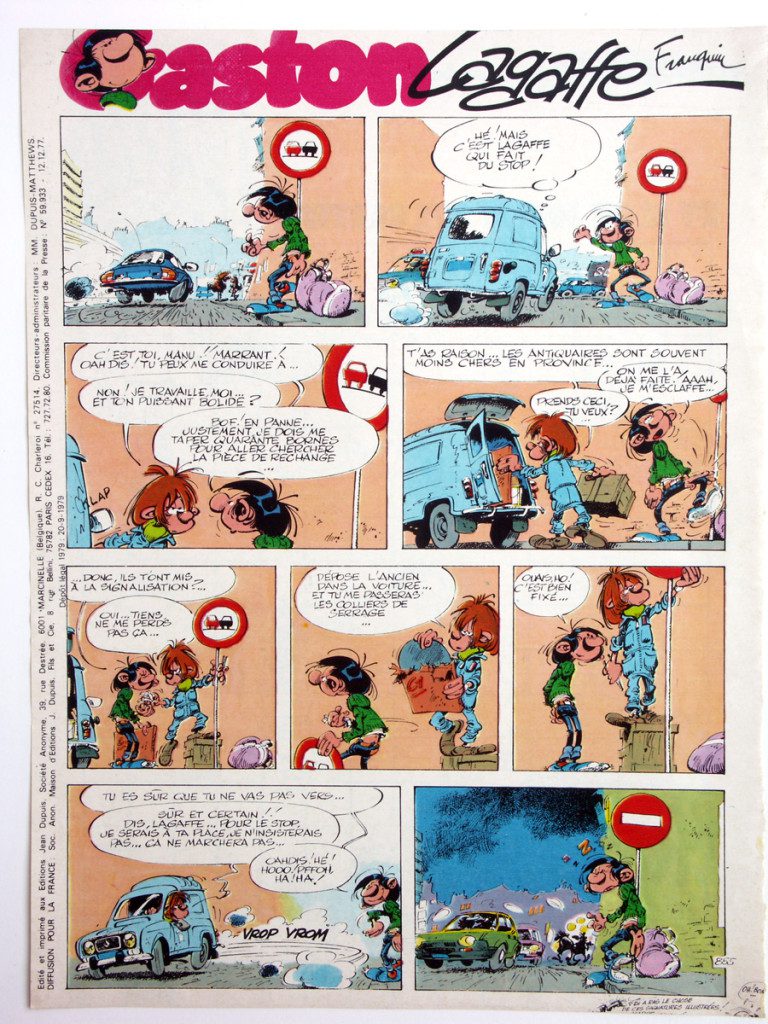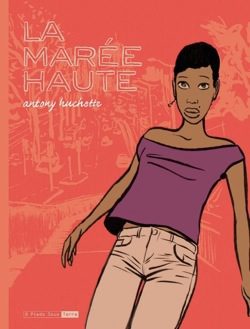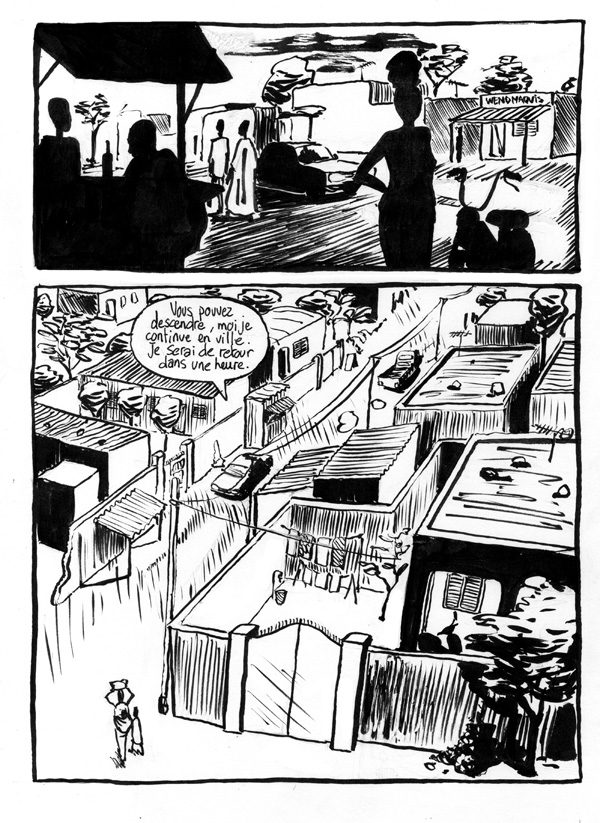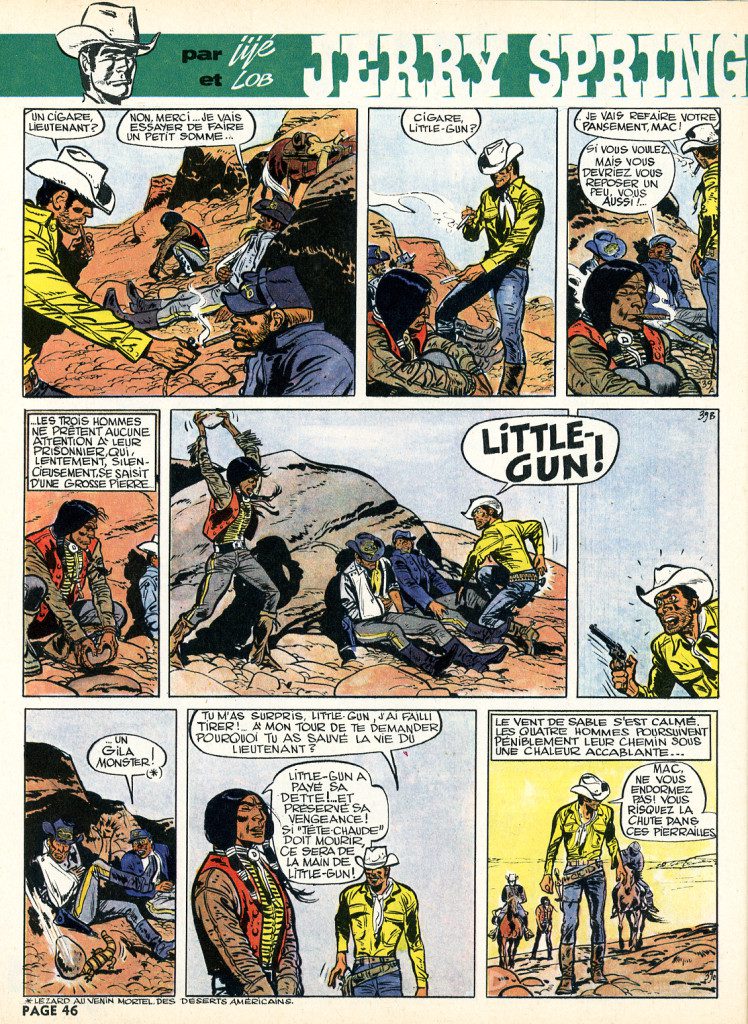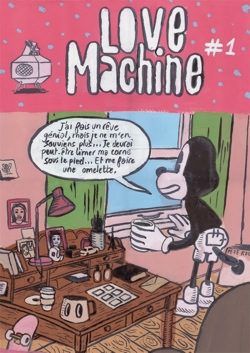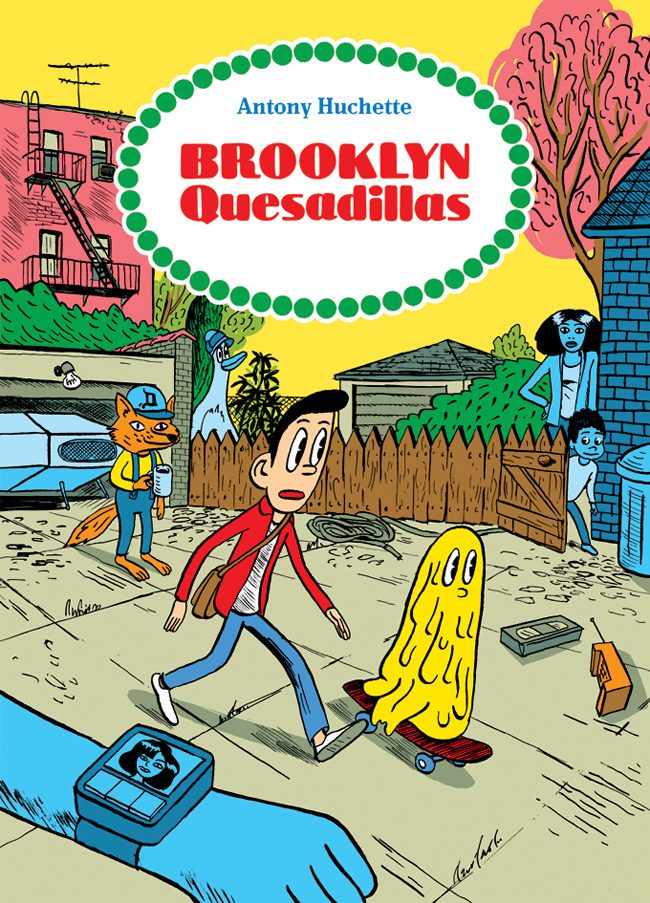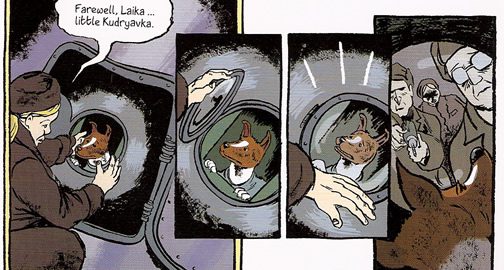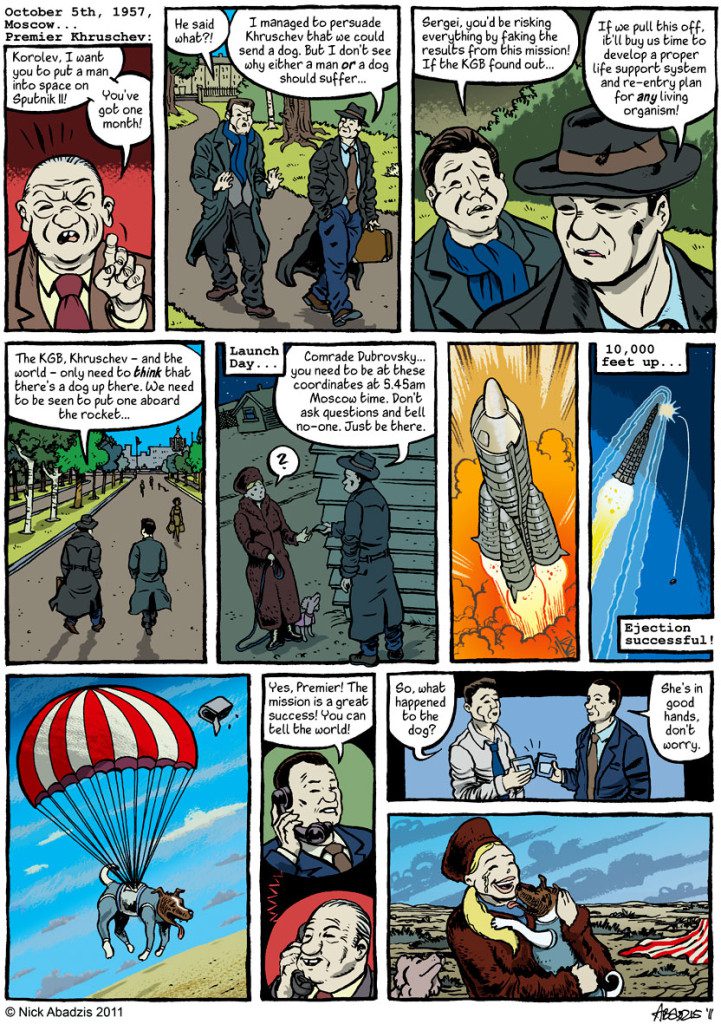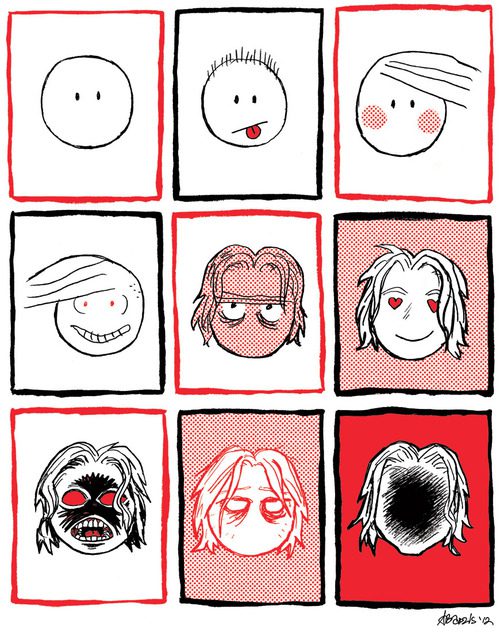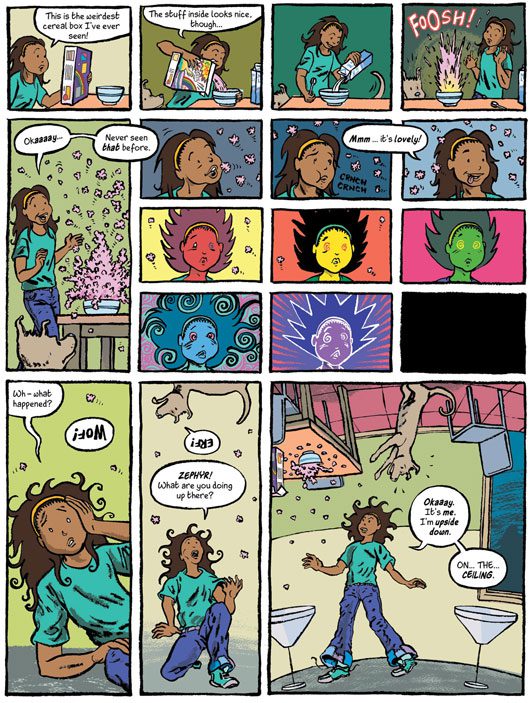The New York Comics & Picture-Story Symposium is a weekly forum for discussing the tradition and future of text/image work. Open to the public, it meets Monday nights 7-9pm EST in New York City. Presentations vary weekly and include everything from historical topics and technical demonstrations to creators presenting their work. Check out upcoming meetings here.
On May 13, the NY Comics and Picture Story Symposium saw presentations by two European-born, New York-based artists, Antony Huchette and Nick Abadzis. Each artist discussed the small and the large, speaking on subjects ranging from childhood memories through first jobs to their larger thoughts on the nature of the comics medium.
Huchette, a French illustrator now living in Brooklyn, presented a survey of his career that culminated in a discussion of his current project, soon to be released in French and English, entitled Brooklyn Quesadillas. His introduction to comics, when his godfather gave him an issue of Spirou featuring Belgian illustrator André Franquin’s Gaston, was the first subject of discussion. Huchette’s practice, as he described it, has been a recurrent search for “the magical feeling of that day,” but finding the actual site itself was fairly mundane. A Google Maps search of the street in the suburbs of Lille where his godfather bought the book revealed only a nail salon. Yet Huchette’s reflection on this circumstance was productive for him. He recognizes in his work, and in the comics medium in general, what he, later in his talk, called “a second chance,” “another possibility,” to recapture the original energy of the site now lost in his memory.
André Franquin, Gaston
Huchette discussed his intermittent interest in comics in order to lead to his description of his own work. His childhood interests were framed by two comics in particular, the aforementioned Spirou and the work of another Belgian illustrator, well-known to American comics artists, Hergé, whose Tintin was given to him by his father. Along with other fare like the Journal de Mickey (the French edition of Mickey Mouse), his early experiences with comics would largely stay within the realm of adventure comics, the only ones available to him. In later adolescence, his interest in the medium faded, although he kept a large box of his earlier favorites with him. With the massive resurgence in France in the 1990s of graphic novels – the “Nouvelle Bandes Dessinées” – Huchette’s interest was again piqued. Discovering the work of other new artists like Blutch (whose late 90s publication, Mitchum, was shown to the audience), Huchette, as he nonchalantly put it, “thought [he] could do something.” Inspired by the liberties the new generation of artists took with abstraction and experimentation, Huchette went on to look more thoroughly at American comics as well; among his favorites he mentioned Daniel Clowes and Chester Brown. His own work would take form at the intersection of these various trends.
Antony Huchette, La Marée Haute
Huchette began to describe his career by discussing the difficult paths he took to create his first work, La Marée Haute (6 pieds sous terre, 2008), the haunting story of a Parisian man who falls in love with an African woman, following her home, only to reawaken in Paris much later, wondering if the events told in the story ever occurred. Many tensions animated Huchette’s production. As he told it, having traveled in Africa in the early 2000s, he began an account of his journeys but, generally disliking autobiography and not wanting to tell the story of “another European in Africa,” the story’s mood and even its subject shifted. Huchette described the work as a love story, but with an admixture of sci-fi elements. On reflection, he now claims to have forgotten the book’s contents; the memories of what he learned in making it are all that have stayed with him. For Huchette, this is a recurring feature of his work – the specifics of a work are left behind, but the creative habits inculcated by it remain.
Antony Huchette, La Marée Haute
The next phase of Huchette’s career began shortly after La Marée Haute was published, when he moved to the United States to attend the School of the Art Institute of Chicago. While there, he gained a much better sense of how, as he put it, “all artistic media nourish each other.” He produced films and paintings, putting comics on hold for a while. Huchette played one of the films he produced in this period, Notes sur la fabrication des souvenirs (available on Vimeo here), a montage of travel footage and animation reminiscent of William Kentridge’s films. During this period, he also explored earlier artists, including Saul Steinberg and the poet Frank O’Hara, whose expressions of New York’s energy he found inspiring.
Jijé, Jerry Spring
Because of his fondness for the physical materiality of the comic, Huchette brought numerous samples of books that had captured his interest over the years, including editions of Belgian artist Jijé’s classic Western Jerry Spring (originally published in Spirou), as well as his own sketchbooks and newest works. The birth of his son required Huchette’s return to France, and turned his focus toward children’s comics, developing in him a fascination for Scrooge McDuck creator Carl Barks. The product of these investigations can be seen in Huchette’s self-published series Love Machine, which he considers a tribute to Barks and Jijé. Love Machine came of Huchette’s interest in using what he called the “Disney Aesthetic” for a more personal project – its subject, Poly, who looks somewhat like a shirtless, earless Goofy crossed with Felix the Cat, wanders in a dreamland, encountering a woman who appropriates Manga for her paintings and his barbecuing “Papa.” Continuing this line of development is Huchette’s new work, Brooklyn Quesadillas, a promotional film for which can be found on his website.
Antony Huchette, Love Machine and Brooklyn Quesadillas
The symposium’s second presenter was seasoned British comics artist, Nick Abadzis, perhaps best known as the creator of Laika, winner of numerous awards, including an Eisner for Best Teen graphic novel in 2008 and Best Foreign Graphic Novel at the Napoli Comicon Awards (although some of us remember him from as far back as his fantastic work, Hugo Tate, serialized in the now-defunct British journal, Deadline, from 1988 to 1995). Rather than discussing his career, Abadzis focused directly on his creative process, taking the audience through the making of a number of different types of work, from the writing and artwork of a comics page to the development of informational designs for the British National Health Service.
Nick Abadzis, Laika
Abadzis began his presentation with a discussion of the first page he created for Laika, a page he noted was not used in the series because of what it showed him about how to do the book. Abadzis came to see that the story of the first living being sent into orbit, a stray dog sent by the Soviet Union in Sputnik 2 in 1957, should be handled as the serious history it was, and that the anthropomorphization of the animal would ruin that. Abadzis had been fascinated with Russian history, and thought that the story of Laika had, ironically, enough human interest to be worth pursuing. His final product was the outcome of sustained effort to convey all of the dog’s emotions he could through his relations to the staff of the Soviet space program. Laika was then shopped around various British and continental European publishers before finding its home at First Second Books.
Nick Abadzis, Laika
Abadzis described himself as someone whose process begins almost wholly in written form. While he is fascinated with comics – as convinced as Huchette that this medium can offer things no other can – he begins by writing script pieces, and searching for the story they belong to, long before proceeding to layouts. Abadzis takes the utmost care with his layouts. Growing up in England, a point of juncture between the great traditions of American and Franco-Belgian comics, he learned early to pay close attention to the rhythm of the page. Since his earliest works, among which was Hugo Tate, his attitude to panel design has been mostly inspired by the latter tradition, which composes very strongly registered pages, with a far greater number of panels per page. Abadzis has to find the right moment to sever the series– the right moment to go to the next page– long in advance of beginning to draw anything.
Nick Abadzis, Hugo Tate
Laika was, for Abadzis, a particularly interesting challenge. Most of his work before that was purely fictional, and self-created. Having to deal with real historical events presented serious problems, but also offered new opportunities. The project was heavily researched, with many trips to the British Library, but as a story it was, in and of itself, full of holes. The Soviets kept no greater record of the day-to-day lives of the scientists who worked on the project than any western country would have, and this gave Abadzis the opportunity to supplement fact with fiction. He could flesh the story out dramatically by focusing on the supporting cast, particularly their relations with their test subject, Laika. As Abadzis put it, the historical record left “human-shaped holes in the narrative.” The passage of the whole project went, as was typical for Abadzis, from dialogue through the environment to the characters, all before proceeding simply to lay the pages out. However, Abadzis does not want to slight the art – as he put it, comics is about immersion, about drawing the reader in far enough that they imaginatively provide the details in the gutter, the space between the panels.
Abadzis does far more than the art for his series. As far back as Hugo Tate, the next subject in his discussion, he had been lettering his work, and coloring it on occasion (although the project for Laika was on a schedule that forbade him from doing all the coloring himself– between signing the contract and the scheduled release date commemorating the fiftieth anniversary of the flight of Sputnik 2 there would not be enough time to do it alone). Abadzis’ lettering method is now digital, although he dislikes the look of anything but hand lettering. Having hurt his hand after several years as a letterer for Marvel UK and the British publisher Fleetway, he can no longer do this, however. His compromise is to have created a font that uses at least three versions of each letter, in order to give the final product a handcrafted look.
Nick Abadzis, Cora’s Breakfast
Abadzis likes the simple as much as the complex. After finishing his discussion of Laika, he proceeded to explain the genesis and development of Hugo Tate, his Deadline series from the late eighties and early nineties. Once known as the “stick figure man,” and composed only of a smiley face attached to a human body, Hugo developed a body and a world around him, at first in and around the UK, and later on a transatlantic journey delineated in the pages of Deadline (the entire run of the series has been available in a trade volume published by Blank Slate, with an introduction by Garth Ennis, since 2012). Abadzis continued by discussing his new work, including Cora’s Breakfast, the story of a young girl and her alien cereal box, for the British children’s comics anthology, the DFC.
Abadzis concluded by discussing the ways he has brought comics to fields far outside conventional storytelling. For the past several years, Abadzis has supplemented his comics work as a development editor for a number of publishers, as well as by producing informational comics for a large varieties of companies, as well as the British government. He believes firmly that the comics medium can enhance the presentation of vital information, and his proof is the series of works he did for the National Health Service to inform citizens of changes to their programs.

